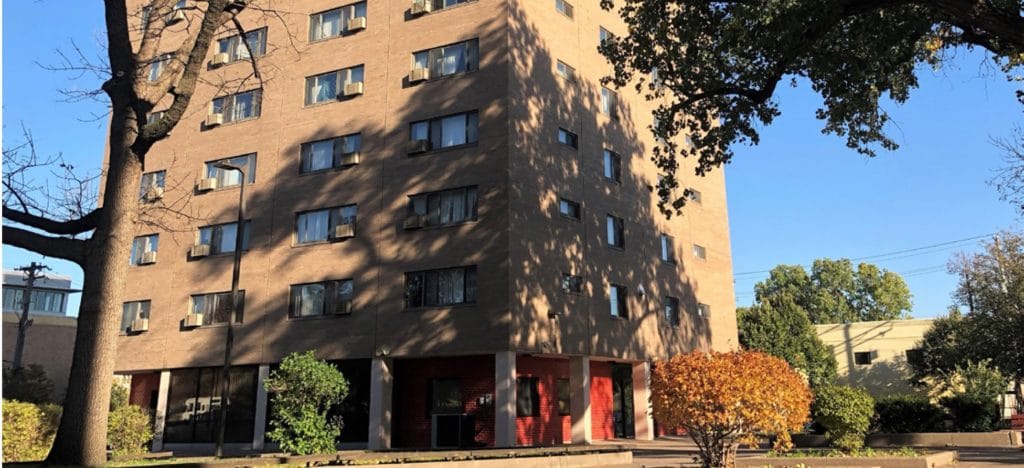
With Minneapolis public housing overdue for modernization and federal money drying up, the Minneapolis Public Housing Authority (MPHA) turned to HUD’s Rental Assistance Demonstration (RAD) program to unlock funds it could use to rehabilitate one of its oldest properties, the Elliot Twins. MPHA had a lot on the line. A successful transaction would provide a path for recapitalizing the rest of its portfolio. Lument’s RAD expertise made it the logical choice for long-term financing.
The Challenge: Finding New Funding for Minneapolis’s Aging Public Housing
Built in 1961, the two 12-story Elliot Twin high-rises were the second oldest buildings in the Minneapolis Public Housing Authority’s (MPHA’s) portfolio — and more than overdue for modernization. But with federal housing dollars becoming harder and harder to locate, the MPHA decided to follow the lead of a handful of other housing authorities, opening up new sources of financing through HUD’s Rental Assistance Demonstration (RAD) program. Essentially, RAD would enable MPHA to use funding sources typically tapped by private and nonprofit affordable housing investors.
RAD deals, however, have many moving parts. In the case of the Elliot Twins, MPHA would have to secure housing revenue bonds from the state of Minnesota and access 4 percent low-income housing tax credits (LIHTC), which would be sold to an equity investor. In addition, MPHA would also have to secure a construction loan and arrange for long-term financing that would kick in once the buildings were stabilized. To fill out the funding stack, it would need to arrange for subordinate loans.
MPHA had a lot on the line. Elliot Twins would be, in effect, a demonstration project, closely watched by city agencies and the community. It would be by far the most ambitious renovation project the authority ever attempted. But if successful, the renovation could provide a template for recapitalizing MPHA’s portfolio, which need an estimated $150 million in repairs.
The Solution: Coordinating and Communicating
The first step toward a solution was to determine how the property would perform financially once it stabilized and was ready to convert from a construction loan. This required Rich Urbano, senior vice president of affordable underwriting, to determine if the interlocking sources of funding added up to a coherent, viable whole and to assess the impact on Lument’s commitment of small changes in the financing stack. “With Rich as underwriter, I felt confident that we could deliver a deal that would work for MPHA,” Reiss added.
Under normal conditions, Urbano’s ability to keep a transaction on schedule is facilitated by his physical proximity to Reiss – their desks are just 15 feet apart. The pandemic upset this arrangement. “Momentum on this project started picking up in March, just around the time everyone was sent home,” Urbano recalled. “That meant we had to be more deliberate about how we communicated. To make sure we were always on the same page, Josh and I set up a daily 9:30 call.”
Another consequence of the stay-at-home orders was an inability to conduct on-site inspections. “Handling inspections was one of the first discussions we had with Freddie Mac which would guarantee the loan,” he said. “Since we were working on a forward commitment that would require an inspection at stabilization, the agency decided to waive the preconstruction inspection.”
Complicating financing was the MPHA’s decision not simply to renovate the buildings but to reconfigure them. In addition to updating the apartments, it is converting offices and common areas that filled the ground and second floors of both buildings into 10 fully disability accessible units and building a community center connecting the buildings that will include larger community rooms, expanded laundry and exercise rooms, and a single secure entrance.
Whenever a transaction involves any form of construction, Urbano depends on Jeremy Glassman, director of engineering and construction management, to scrutinize engineering, construction plans, and third-party reports. “Having him on this transaction was a huge benefit, Urbano said. “His attention to detail ensured that the contracts, plans, and budgets were all in sync.”
Reconfigure and renovate
Complicating financing was the MPHA’s decision not simply to renovate the buildings but to reconfigure them. In addition to updating the apartments, it is:
Whenever a transaction involves any form of construction, Urbano depends on Jeremy Glassman, director of engineering and construction management, to scrutinize engineering, construction plans, and third-party reports. “Having him on this transaction was a huge benefit, Urbano said. “His attention to detail ensured that the contracts, plans, and budgets were all in sync.”
The Impact: Creating Appealing Homes for Low-Income Citizens

At the end of May, a Minneapolis police officer killed George Floyd, sparking protests against police brutality and systemic racism in Minneapolis and across the United States. “There was not one partner who waivered in seeing the project through,” Urbano said. “If anything, the riots underscored its importance.” As part of the $25 million recapitalization of Elliot Twins, Lument provided an $11.8 million Freddie Mac tax-exempt loan.
The impact of the Elliot Twins renovation won’t begin to be apparent until construction is completed in 2022, and the last occupants have returned to their apartments. Ultimately, the impact of RAD recapitalization will be measured in the effect that more pleasant, modern, comfortable homes have on the lives and prospects of the community’s residents.
“With the Elliot Twins, we set off to fulfill our vision to preserve public housing across Minneapolis,” said MPHA Executive Director/CEO Abdi Warsame. “This extensive and attractive renovation will transform the lives of the people who live there. It will also embody our joint commitment with the city to invest in high-quality, long-lasting, appealing homes for our lowest-income citizens.”